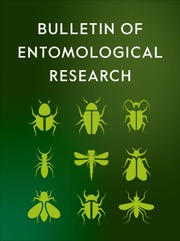No CrossRef data available.
Article contents
Time series analysis of nuptial flights of Afrotropical ants (Hymenoptera: Formicidae), and the influence of moonlight on catches
Published online by Cambridge University Press: 31 March 2025
Abstract
Data from three and half years’ nightly light-trap catches of 25 Afrotropical ant species were examined by Fourier analysis. Between 8 and 72 % of the seven-day-moving-average logarithmically transformed catches were accounted for by two to four terms. All 25 species showed significant annual periodicity and all, but Dorylus fulvus and Camponotus foraminosus, six monthly. Four species had wavelengths of between two and four years, and Tapinoma melanocephalum of 289 days. Twenty-three species showed two peak catches annually, contemporaneous with the two rainy seasons, with the higher peak corresponding with the main rains for 21 of them, while D. fulvus and C. foraminosus had single annual peaks during the main rains. Catches of 14 species with lunar periodicities were lowest around full moon and highest near new moon, contrasting with Hypoponera dulcis and Plagiolepis brunni whose catches were highest at full moon, and near the first quarter, respectively. Gynes and males of eight species were sufficiently numerous for comparisons of their separate responses to lunar illuminance. Catches of males peaked ca. six and three days later than gynes for Tapinoma cf. carininotum and Tetramorium aculeatum, respectively; whereas males of Crematogaster africana, Cr. depressa, Tetramorium sericeiventre, Oecophylla longinoda, Tapinoma melanocephalum, and Technomyrmex andrei peaked from ca. one to six days earlier than their respective gynes.
- Type
- Research Paper
- Information
- Copyright
- © The Author(s), 2025. Published by Cambridge University Press.



